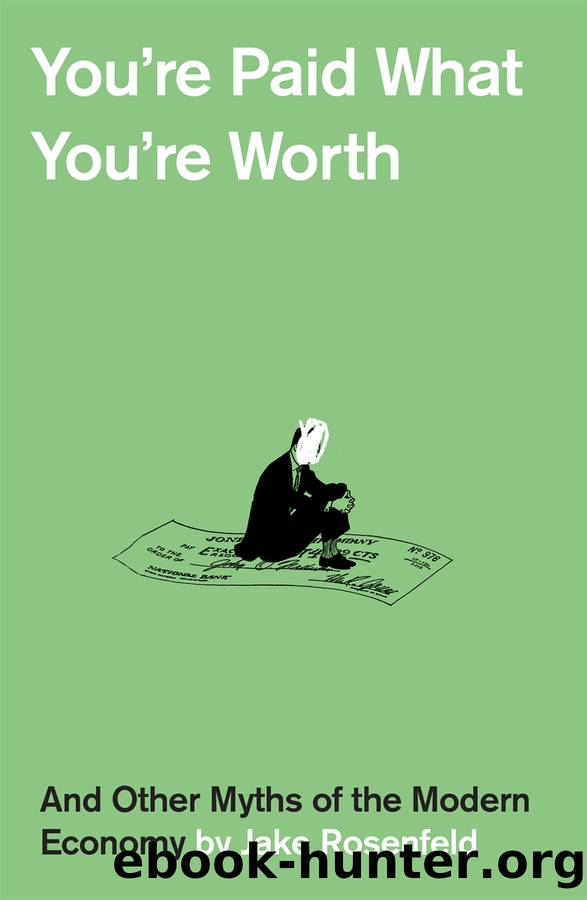You're Paid What You're Worth by Jake Rosenfeld

Author:Jake Rosenfeld
Language: eng
Format: epub
Publisher: Harvard University Press
For Walmart, the equation was simple: higher pay means either hurting shareholders (an increasingly treacherous route to take, as weâve learned) or hurting consumers through higher prices. But in fact, the empirical literature on the relationship of pay and prices in the retail and restaurant industries presents a mixed set of findings. One study, by Daniel Aaronson, focused on the pricing patterns in the restaurant industry in the United States and Canada. After legislation raised the minimum wage in various states and provinces, the cost of restaurant food did increase. But the increase was quite modest, and limited to the period surrounding the legislative change.15 Sara Lemosâs review of existing research on minimum wages and prices makes no greater case that pay hikes lead to price hikes: many studies find a small effect and some studies find no effect at all.16 Lemos concludes that raising the minimum wage in industries like retail and fast food âincreases the wages of the poor, does not destroy too many jobs and does not raise prices by too much.â17 The red-hot economy of the late 1990s helped to produce record-low unemployment and robust wage gains throughout industries, including retail. Prices for retail goods, however, remained essentially flat.18
How come? As Costco has demonstrated, well-paid workers often make happier and more loyal workers, and happier and more loyal workers work more productively. As anyone who has slogged through a lousy job under a lousy boss knows, the combination of low pay and poor management is enervating. Wage increases, meanwhile, donât just motivate employees. Higher labor costs can also shake employers out of complacency, leading them to innovate more in their search for other ways to beat competitors. As Carré and Tilly conclude, ânothing gets employers thinking harder about ways to increase productivity than blocking the low-wage solution.â19
So far, other retailers have largely eschewed innovative thinking and resorted instead to the copycat approach. As one executive in the late 1990s lamented, âWhen a competitor comes in, you have to mimic their operations, and you get reduced to the lowest common denominator.â20 Walmart has proven especially tempting to mimic, a fact that the companyâs critics have long recognized. In the spring of 2005, five members of Congress and a former Miss America joined with unions and other worker advocates to shame Walmart for the companyâs gender pay disparities and general low pay. As part of the âLove Mom, Not Wal-Martâ campaign, the participants signed an eight-by-eight-foot Motherâs Day card addressed to CEO Lee Scott, urging him to remedy sex-based discrimination and raise rock-bottom wages. Congresswomen Rosa DeLauro of Connecticut, one of the giant cardâs signees, said Walmartâs massive scale meant it was especially obliged to serve as a positive model for others: âcertainly, as the nationâs wealthiest and largest employer and largest company, Wal-Mart has a unique role and responsibility to do the right thing and set the best standard for America.â21 Having industry behemoths set higher standards is important because mimicry often leads to inertia. The pay
Download
This site does not store any files on its server. We only index and link to content provided by other sites. Please contact the content providers to delete copyright contents if any and email us, we'll remove relevant links or contents immediately.
| Anthropology | Archaeology |
| Philosophy | Politics & Government |
| Social Sciences | Sociology |
| Women's Studies |
Cecilia; Or, Memoirs of an Heiress — Volume 1 by Fanny Burney(31375)
Cecilia; Or, Memoirs of an Heiress — Volume 3 by Fanny Burney(30969)
Cecilia; Or, Memoirs of an Heiress — Volume 2 by Fanny Burney(30923)
The Great Music City by Andrea Baker(22458)
We're Going to Need More Wine by Gabrielle Union(18111)
Bombshells: Glamour Girls of a Lifetime by Sullivan Steve(13142)
Pimp by Iceberg Slim(12975)
All the Missing Girls by Megan Miranda(12814)
Fifty Shades Freed by E L James(12479)
Talking to Strangers by Malcolm Gladwell(11956)
Norse Mythology by Gaiman Neil(11942)
Crazy Rich Asians by Kevin Kwan(8396)
Mindhunter: Inside the FBI's Elite Serial Crime Unit by John E. Douglas & Mark Olshaker(7875)
The Lost Art of Listening by Michael P. Nichols(6514)
Enlightenment Now: The Case for Reason, Science, Humanism, and Progress by Steven Pinker(6435)
Bad Blood by John Carreyrou(5801)
The Four Agreements by Don Miguel Ruiz(5552)
Weapons of Math Destruction by Cathy O'Neil(5080)
We Need to Talk by Celeste Headlee(4906)
